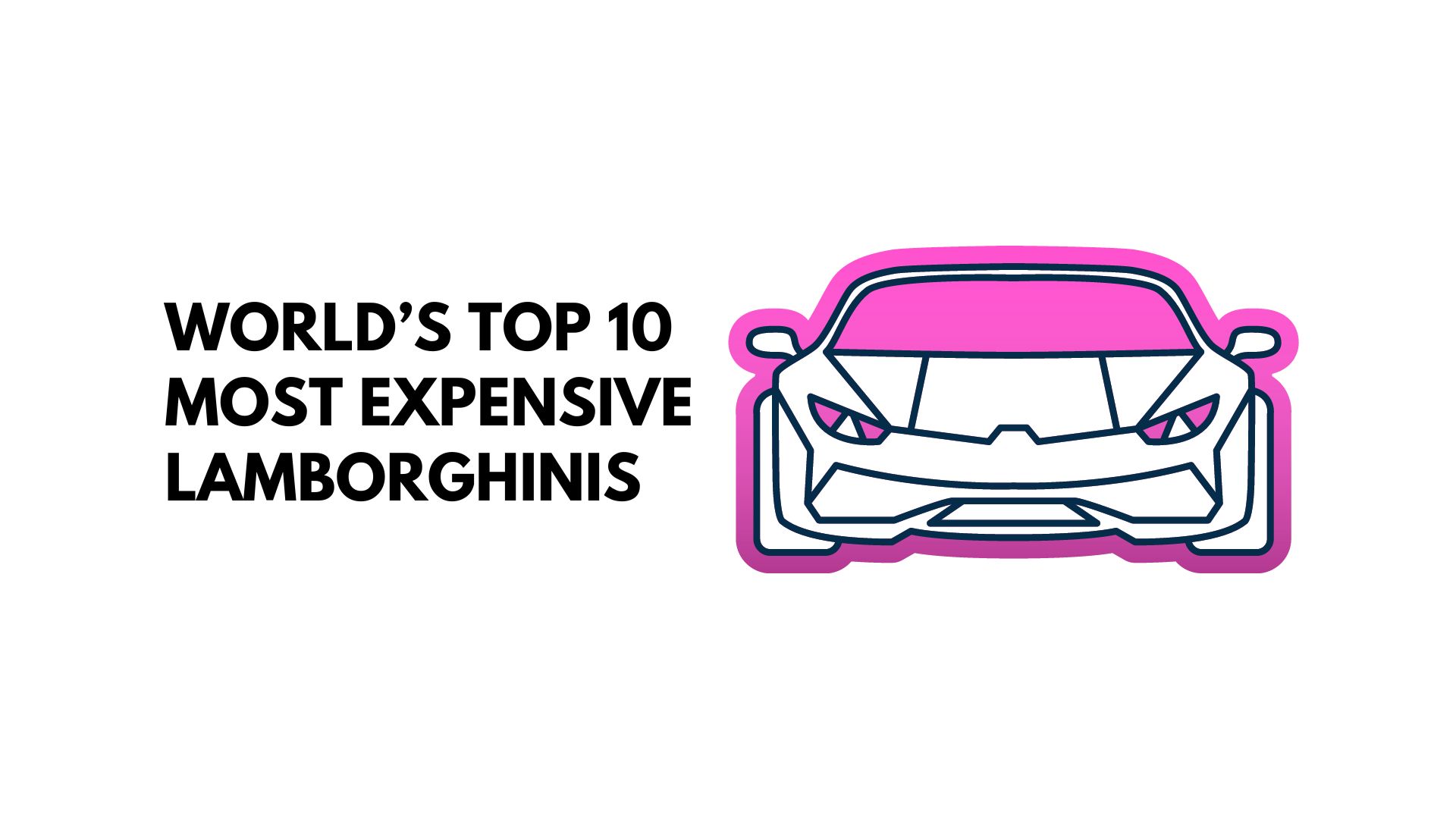Top 10 Most Expensive Spices In The World
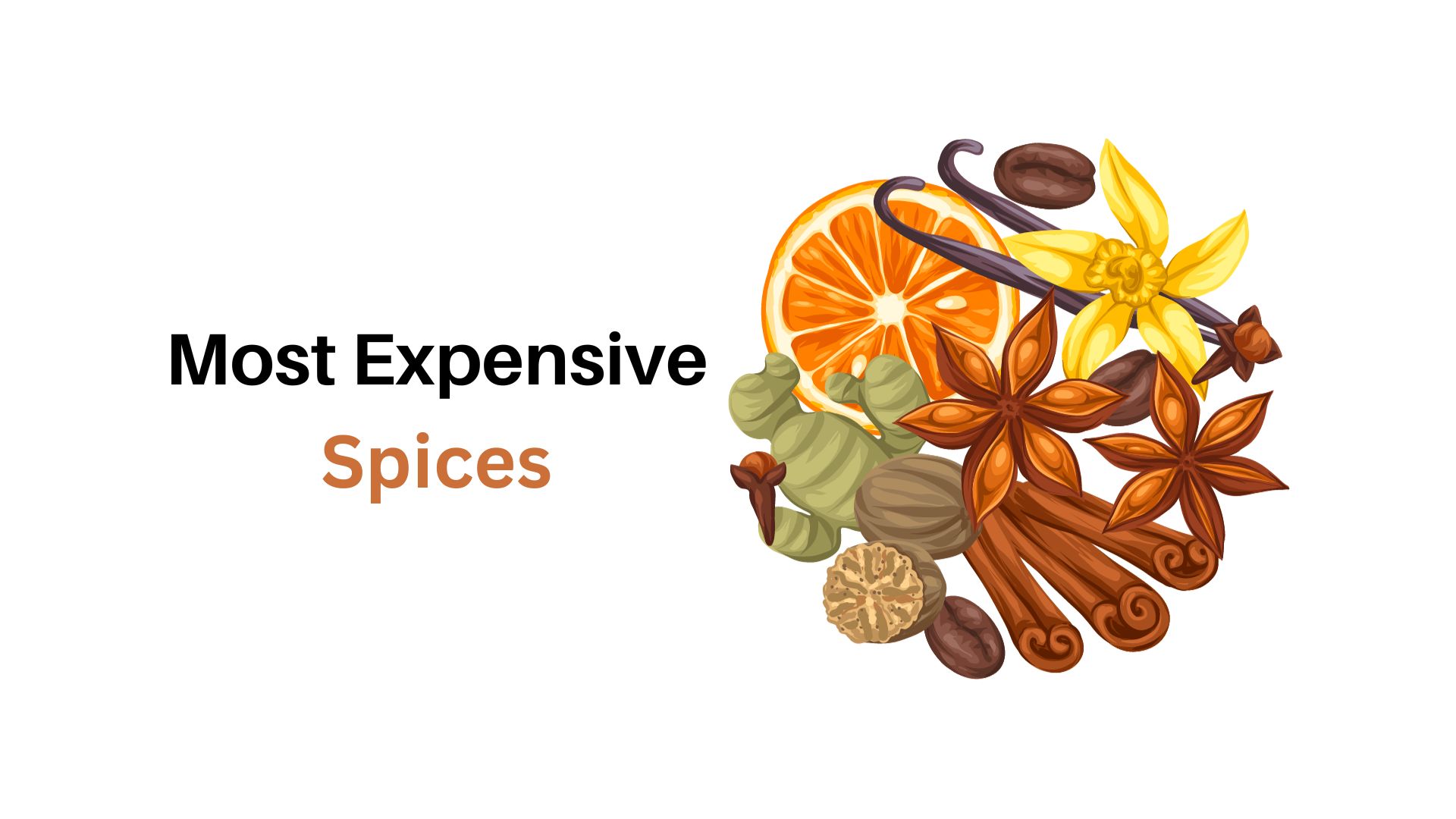
Page Contents
What are Spices?
Most Expensive Spices: Spices are special ingredients that come from different parts of plants, like roots, bark, flowers, fruits, or seeds. They can be sweet or strong and come from plants. People have used them in cooking for thousands of years. They're important in many types of food from different countries.
Common spices are black pepper, cinnamon, cumin, coriander, cardamom, cloves, ginger, and turmeric. Each one tastes different and can be used in both sweet and spicy foods.
People often mix spices with other ingredients like herbs to make food taste even better. For example, in Indian food, they use a mix called garam masala with spices like cardamom, cinnamon, cloves, cumin, and coriander to make curries and other dishes taste great.
Spices are also good for health. Some, like ginger and turmeric, can help with inflammation, digestion, and keeping the immune system strong.
Spices are really important in cooking for making food taste, smell, and look good. They come from different parts of plants and have been used in cooking all around the world for a very long time.
History of Spices
Spices have a long and interesting history that goes back thousands of years. Ancient people in Egypt, India, China, and the Middle East used spices a lot. They liked them for their taste, health benefits, and how they could keep food fresh. Spices were very valuable and traded all over the place. This trading helped connect different countries and was a big part of how people did business back then.
The Silk Road, a bunch of trading paths, was really important for bringing spices from Asia to Europe. The Mediterranean area was also a key route, with ancient Greeks and Romans getting spices from Egypt and the Middle East.
During the Middle Ages, spices were very important in Europe. They showed wealth and power. Spices like pepper, cinnamon, and cloves made food tasty and covered up the bad taste of old meat. People also used them in medicine and perfumes. Spices were so valuable that they were used like money and sometimes even to pay rent.
The high demand for spices in Europe led to the Age of Exploration. Countries like Spain, Portugal, and England wanted to control the spice trade. The Portuguese were the first to make trade routes to Asia and soon controlled the spice trade. Later, the Dutch had a monopoly on trading spices, and the British East India Company also became a big player.
Today, spices are still a big part of cooking worldwide. They add flavor, color, and aroma to food and are linked to specific types of cooking like Indian, Thai, and Mexican. Spices are also used in traditional medicines and are believed to have health benefits like reducing inflammation and improving digestion.
The story of spices shows how important trade and business were in the development of human civilization. Spices have been a key part of the economy, cooking, and culture of many societies and are still highly valued today.
Types of Spices
They're really important in cooking and can change how a dish tastes. Here are some common types of spices:
- Black pepper: This is the most used spice. It's made from the berries of the Piper nigrum plant and tastes strong and a bit sharp.
- Cinnamon: This spice comes from the inner bark of Cinnamomum trees. It's sweet and warm, often used in baking.
- Ginger: Ginger is a root spice with a strong, spicy taste. It's used a lot in Asian cooking, both for flavor and as a medicine.
- Turmeric: This spice is from the Curcuma longa plant's root. It's bright yellow and tastes warm and slightly bitter. Turmeric is known for being good for health.
- Cloves: Cloves are the dried buds of the Syzygium aromaticum tree. They taste strong and spicy and are used in both sweet and spicy dishes.
- Cardamom: This spice comes from the seeds of the Elettaria cardamomum plant. It's sweet and spicy and used a lot in Indian and Middle Eastern cooking.
- Cumin: Cumin is from the seeds of the Cuminum Cyminum plant. It tastes warm and earthy and is used in Mexican, Middle Eastern, and Indian cooking.
- Nutmeg: Nutmeg is from the seed of the Myristica fragrans tree. It tastes warm and sweet, mostly used in baking.
- Paprika: Paprika is made from ground sweet or hot peppers. It tastes sweet and a bit sharp, used a lot in Spanish and Hungarian cooking.
- Saffron: Saffron comes from the stigma of the Crocus sativus flower. It has a strong, unique taste and is one of the most expensive spices.
Top 10 Most Expensive Spices In The World
- Saffron – (Worth USD 1000 To 5000 Per Pound)
- Fennel Pollen – (Worth USD 30 Per Ounce)
- Pure Vanilla – (Worth USD 20 For 6-8 Pods)
- Mahlab – (Worth USD 5-6 Per Ounce)
- Long Pepper – (Worth USD 5 Per Ounce)
- Black Cumin Seed – (Worth USD 3 Per Ounce)
- Dried Keffir Lime Leaves – (Worth USD 35 Per Pound)
- Grains of Paradise – (Worth USD 31 Per Pound)
- Cardamom – (Worth USD 30 Per Pound)
- Pasilla de Oaxaca Chile – (Worth USD 28 Per Pound)
#1. Saffron – (Worth USD 1000 To 5000 Per Pound)
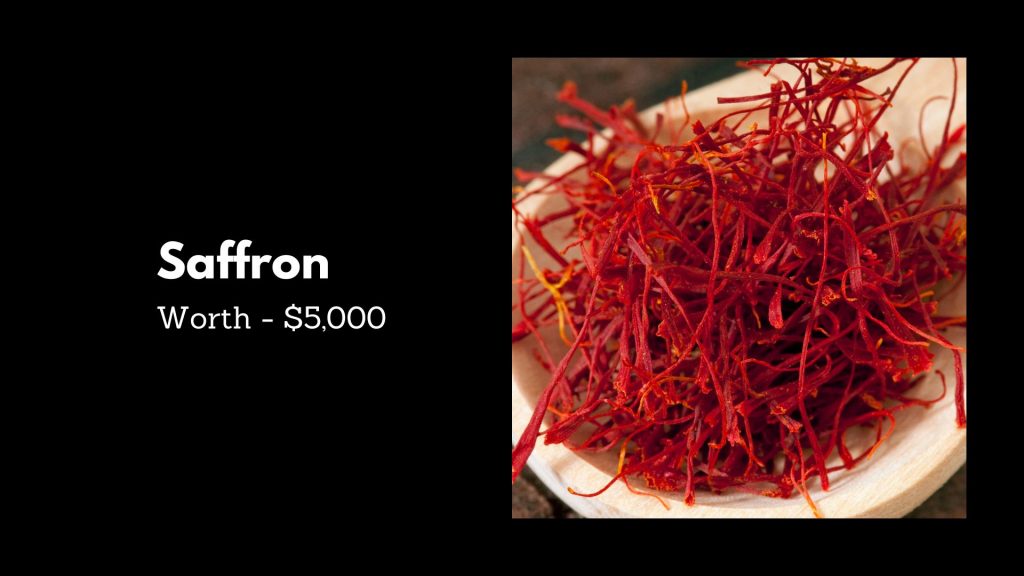
Saffron is one of the Most Expensive Spices, known for its unique flavor and color. Saffron is a very special spice that comes from the Crocus sativus flower. People love it for its unique smell, taste, and color. It has a long history, used since ancient times for health, dyeing clothes, and making cosmetics.
Saffron is made from the threads of the flower, which are picked and dried. It takes a lot of flowers to make a little bit of saffron, which is why it's one of the most expensive spices in the world. People often call it “red gold” because of its high price.
Iran, Spain, India, and Greece are the main places where saffron is grown, and each place has its own type of saffron. The best saffron is deep red, smells strong, and tastes a bit sharp.
In cooking, saffron is used in dishes like paella, risotto, and bouillabaisse to give them flavor and color. It's also in sweets like ice cream and cakes. Saffron is often mixed with other spices like cumin, coriander, and cinnamon to make interesting flavors.
Saffron has been used as a medicine for a long time too. It's thought to help with inflammation, act as an antioxidant, and improve mood. It's been used to treat things like depression, anxiety, and menstrual cramps. But, more research is needed to fully understand how good it is for health. Saffron is a very valuable and versatile spice that brings a unique taste and color to many dishes. Even though it's expensive, many people think it's worth it for the amazing flavor it adds.
#2. Fennel Pollen – (Worth USD 30 Per Ounce)
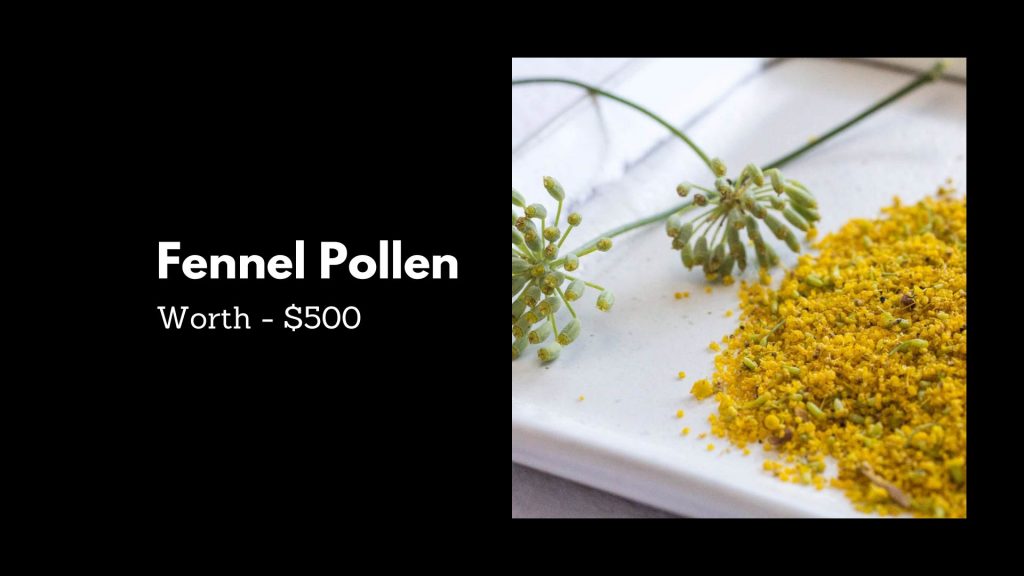
Fennel Pollen stands out as the second Most Expensive Spices, offering a distinct taste. Fennel pollen is a really sweet spice from the flowers of the fennel plant. It's a special and rare spice, usually picked by hand in small amounts. It tastes sweet, a bit like licorice, with a flowery hint.
In Italian cooking, especially in Tuscany, fennel pollen is popular. It's used to add flavor to meat, fish, and vegetables. It's also used in making some special salami and sausages. Besides savory dishes, it's in sweet treats like gelato and panna cotta.
Fennel pollen is getting more popular in modern cooking. Chefs use it in different dishes, like seafood and creative recipes. Because it's expensive and rare, it's usually used in small amounts to add a special, rich flavor to dishes.
Fennel pollen is also thought to be good for health. It has antioxidants, which might help reduce inflammation in the body. Some research even says it might help fight cancer, but more studies are needed to be sure.
Fennel pollen is a unique and flexible spice that adds a complex flavor to many dishes. Even though it's pricey and hard to find, chefs and food lovers like it for its special taste and possible health benefits.
#3. Pure Vanilla – (Worth USD 20 For 6-8 Pods)
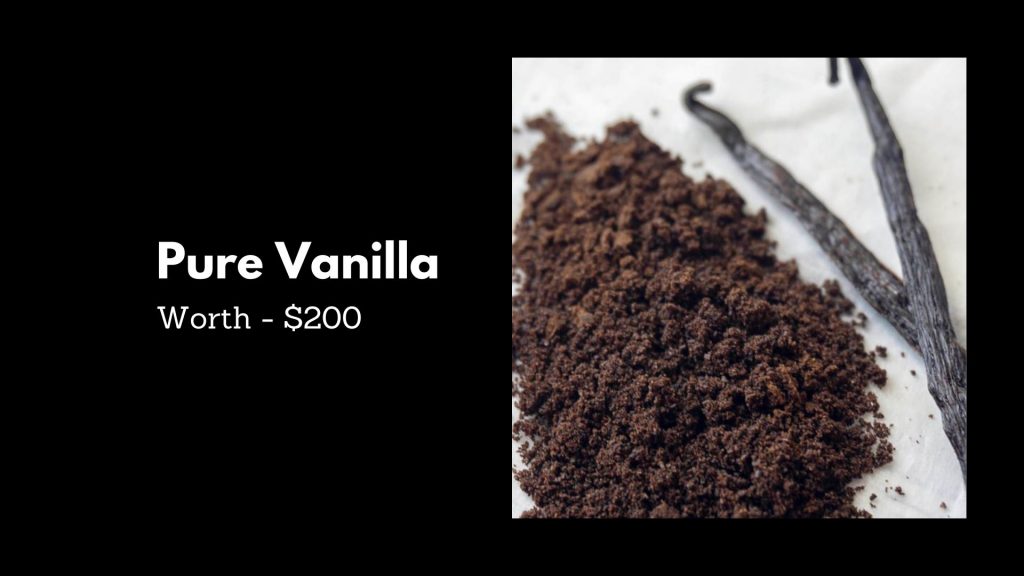
Pure Vanilla is considered among the Most Expensive Spices due to its labor-intensive cultivation. Vanilla beans come from a special kind of orchid that originally grows in Mexico and Central America. They are famous for their sweet and unique taste, and are used in lots of recipes. Vanilla is one of the most popular flavors in the world, known for its great taste and smell.
The vanilla plant is a long vine, reaching up to 25 meters. Its flowers need to be pollinated by hand because the usual pollinators aren't found everywhere. Once pollinated, the flowers turn into long pods, which are the vanilla beans. People pick these pods by hand, and then they go through a long process of curing and drying to get them ready.
Vanilla beans are used in many foods like cakes, ice cream, coffee, and even some main dishes. The flavor of vanilla is sweet, a bit floral, and slightly woody. Its smell is warm and comforting.
People also think vanilla beans are healthy. They have antioxidants, which might help with inflammation in the body. Some studies say vanilla might even help fight cancer, but we need more research to be sure.
Vanilla beans can be expensive because a lot of people want them. There have been issues with fake or diluted vanilla products. Lately, efforts are being made to farm vanilla more sustainably and to solve problems of fraud in the vanilla business.
Vanilla beans are a flexible and beloved spice that adds a rich and unique flavor to many kinds of dishes. They make baking, cooking, and even drinks like coffee more enjoyable with their warm and sweet taste.
#4. Mahlab – (Worth USD 5-6 Per Ounce)
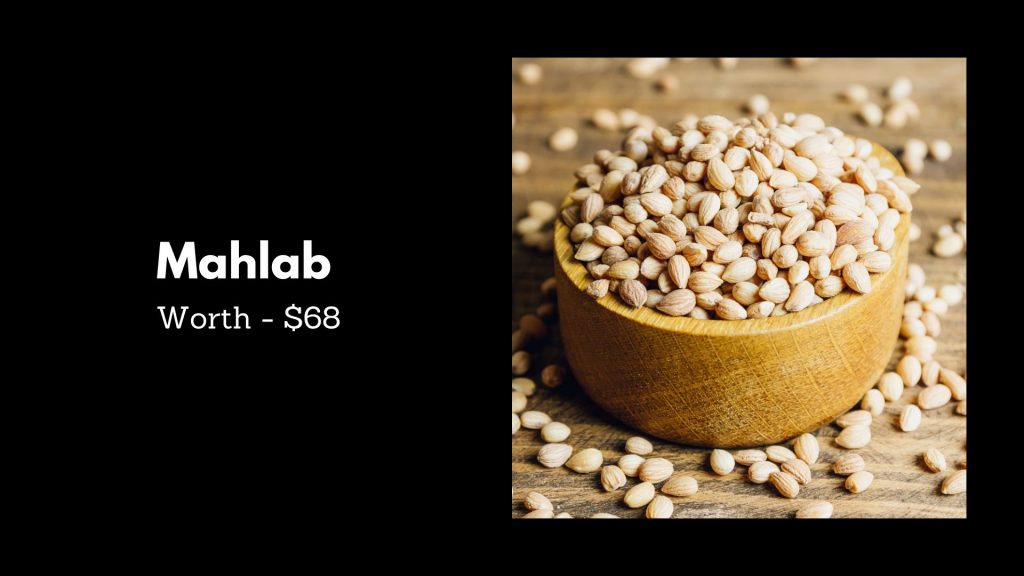
Mahlab is valued as 4th Most Expensive Spices, cherished for its sweet and nutty flavor. Mahlab, also called mahleb, is a spice from the seeds of a cherry tree named Prunus mahaleb. This tree is found in the Middle East and around the Mediterranean. People have used its seeds as a spice for a very long time.
Mahlab tastes unique, sweet, and a bit sharp, kind of like almonds and cherries. It's often used in cooking in the Middle East, Greece, and Turkey, especially for making bread, pastries, and desserts. In Greece, for example, it's a key ingredient in a traditional Easter bread called tsoureki. Mahlab is usually sold as whole seeds that you need to crush with a mortar and pestle or in a spice grinder before you use it.
It's worth knowing that mahlab seeds have a tiny amount of hydrocyanic acid, which can be harmful in large amounts. However, the amount in mahlab is generally safe to eat in small amounts.
Mahlab is a unique and delicious spice that adds a special flavor to many sweet dishes.
#5. Long Pepper – (Worth USD 5 Per Ounce)
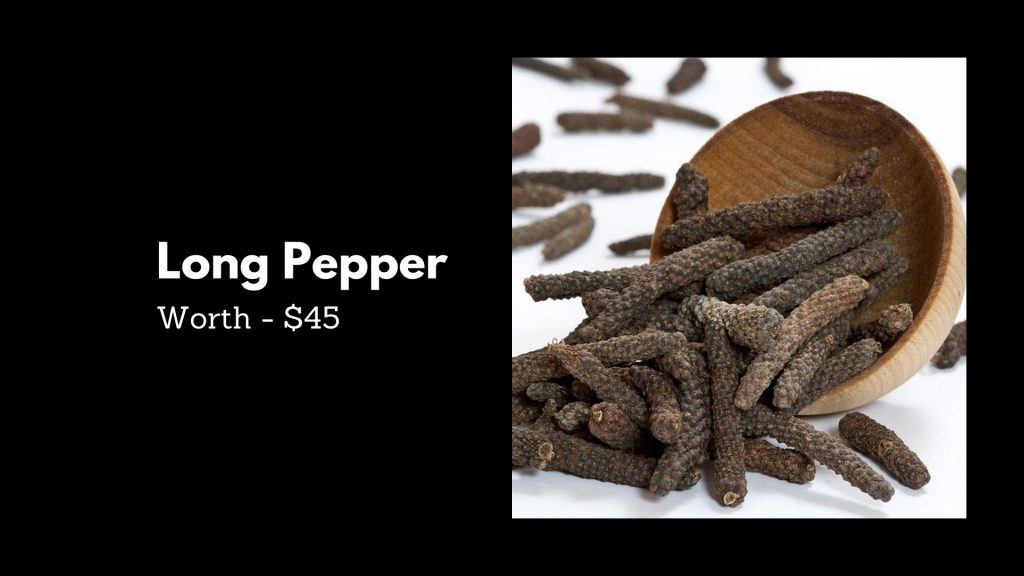
Long Pepper ranks as 5th Most Expensive Spices, sought after for its bold taste. Long pepper, also called Pippali, is a spice made from the dried fruit of a plant called Piper longum. It's from India and Southeast Asia and has been used for many years in traditional medicine and cooking.
Long pepper is spicy, a little sweet, and smells strong. It's added to foods like curries, stews, and pickles to make them taste better. In Ayurvedic medicine, which is a type of traditional medicine, long pepper is used to help with digestion and to treat breathing and immune system problems.
When you buy long pepper, it's usually dried and whole. You can grind it up with a tool like a mortar and pestle or a spice grinder. Long pepper contains something called piperine, which helps your body take in nutrients and medicines more effectively.
Lately, long pepper has become popular with cooks and food enthusiasts because of its unique flavor and how it can be used in different dishes. It can be used instead of black pepper or mixed with other spices like cinnamon, cardamom, and cloves to create tasty spice mixes.
Long pepper is a unique spice that has been used for a long time in both cooking and for health reasons.
#6. Black Cumin Seed – (Worth USD 3 Per Ounce)
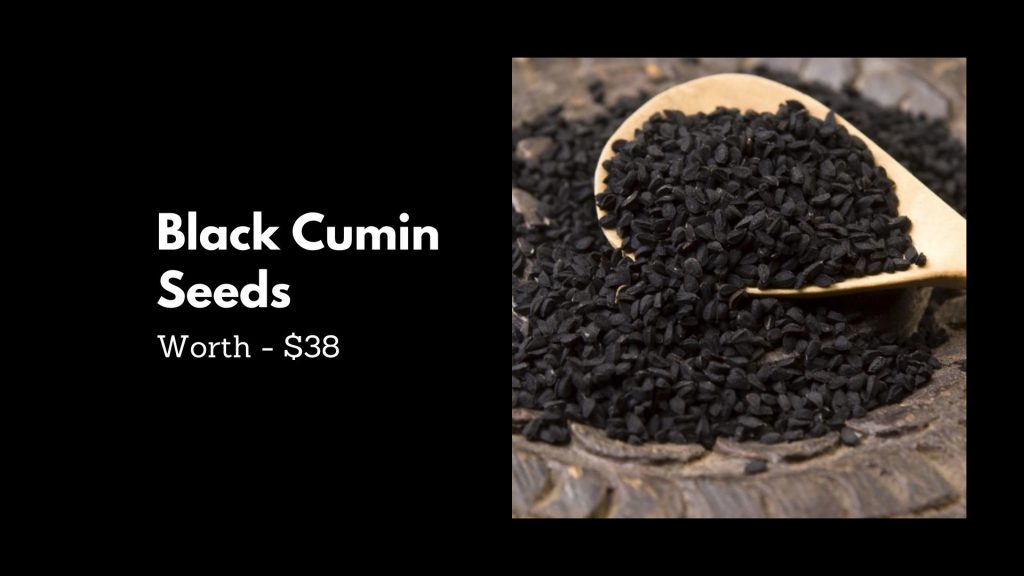
Black Cumin Seed is recognized as one of the Most Expensive Spices, notable for its health benefits. Black cumin seed, also known as Nigella sativa, is a spice that comes from the Nigella plant. This plant grows in Southwest Asia and around the Mediterranean. People have used black cumin seeds in cooking and traditional medicine for a very long time.
These seeds taste a bit bitter and nutty and have a strong smell. They are added to different foods like curries, soups, and stews to make them taste better. Black cumin seeds are also used in old-fashioned medicine to help with breathing problems, digestion issues, and skin problems.
Black cumin seeds are full of antioxidants and are known to help reduce inflammation, fight germs, and boost the immune system. They are also a good source of healthy fats and other important nutrients, making them a healthy choice for any meal.
Usually, black cumin seeds are sold whole. You can grind them with a mortar and pestle or a spice grinder. You can also make a tasty oil from these seeds, which is used in cooking and as a skincare product.
Black cumin seed is a useful and healthy spice that has been valued for its taste and healing properties for many years.
#7. Dried Keffir Lime Leaves – (Worth USD 35 Per Pound)
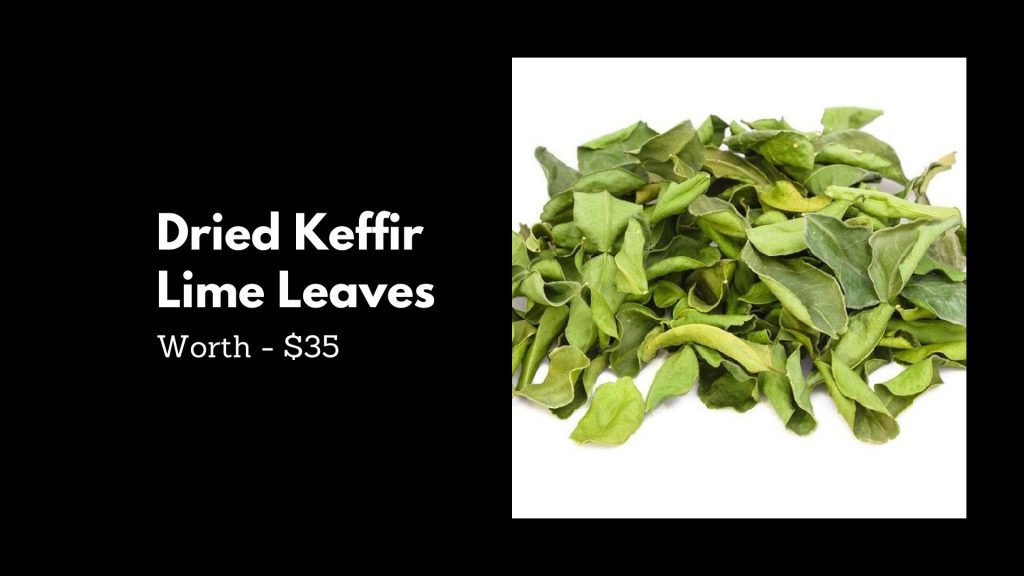
Dried Kaffir Lime Leaves are among the Most Expensive Spices, essential in many Asian cuisines. Kaffir lime leaves, also known as Makrut lime leaves, are a spice from the Kaffir lime tree (Citrus hystrix). This tree is from Southeast Asia, and the leaves are used a lot in Thai, Indonesian, and Malaysian cooking.
These leaves have a strong, nice smell and a taste that's sharp and a bit bitter. They're often added to soups, curries, stir-fries, and sauces to give them more flavor. You can use the leaves fresh or dried, and they're usually put into dishes whole.
Kaffir lime leaves are also known for being good for health. They have lots of antioxidants and are said to help with inflammation, fight germs, and aid digestion. In traditional medicine, they are used to treat things like colds, flu, and stomach issues.
You can find Kaffir lime leaves fresh or dried at Asian markets or specialty food stores. You can also grow them yourself in a warm, humid place. When using fresh leaves, it's a good idea to remove the tough middle stem before chopping or using them in recipes.
Kaffir lime leaves are a flexible and tasty spice that adds a special flavor to many Southeast Asian dishes.
#8. Grains of Paradise – (Worth USD 31 Per Pound)
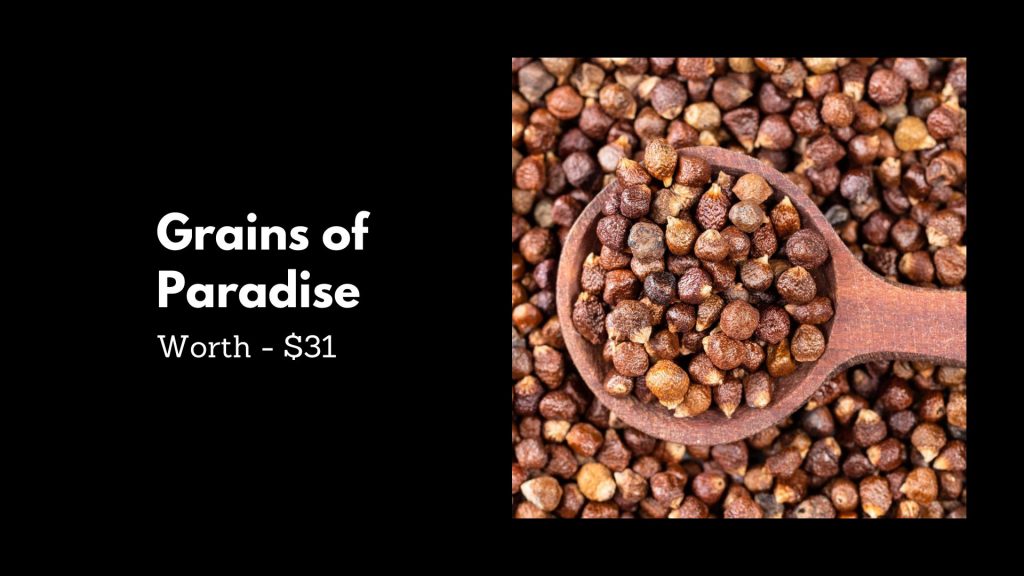
Grains of Paradise are counted as one of the Most Expensive Spices, known for their peppery flavor. Grain of Paradise is a spice from the seeds of the Aframomum melegueta plant, found in West Africa. It's also called alligator pepper, Guinea pepper, and Melegueta pepper. This spice tastes a bit spicy and warm, with hints of citrus and ginger. It's used a lot in cooking in West Africa, the Middle East, and North Africa.
For a long time, people have used Grain of Paradise in traditional medicine because it can help reduce inflammation, fight off germs, and is full of antioxidants. It's also thought to help with digestion and ease stomach aches. Studies even suggest that Grain of Paradise might be good for managing weight, reducing body inflammation, and improving how the brain works.
Apart from its health benefits, Grain of Paradise is used to add flavor to alcoholic drinks like gin and beer. It's also in spice mixes, soups, and sauces. You can buy Grain of Paradise as whole seeds or ground into a powder. To keep its flavor and smell, it should be stored in an airtight container in a cool, dark place.
#9. Cardamom – (Worth USD 30 Per Pound)
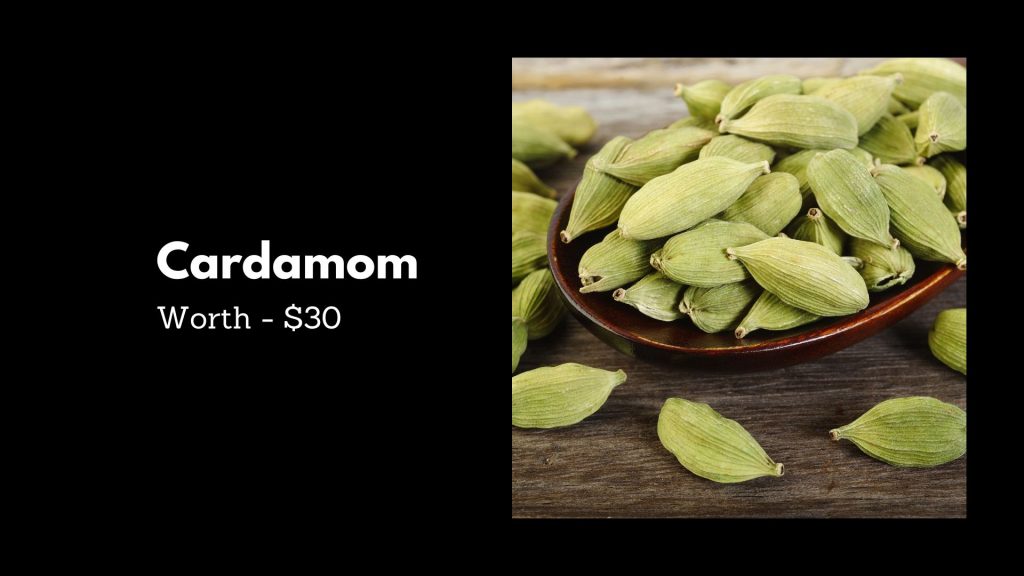
Cardamom is categorized as one of the Most Expensive Spices, popular in both sweet and savory dishes. Cardamom is a spice from the seeds of plants in the Elettaria and Amomum families. These plants are from India, Nepal, and Bhutan. Cardamom is known for its unique, sweet, and fragrant flavor, making it a favorite in many types of cooking, especially in South Asia and the Middle East.
There are two main types of cardamom: green and black. Green cardamom, which is more common, is light green and has a fresh, flowery smell with hints of citrus and mint. Black cardamom has a darker, earthy taste with a bit of a menthol flavor.
People have used cardamom in traditional medicine for a long time because it has many health benefits. It's full of antioxidants and has essential oils and compounds, like terpenes, that give it its special flavor and smell. Studies show that cardamom might help with digestion, freshen breath, lower blood pressure, and reduce inflammation.
Cardamom is a flexible spice used in both sweet and savory dishes. It's often in Indian and Middle Eastern recipes for flavoring curries, rice dishes, and baked goods like cakes and pastries. It's also common in coffee and tea, especially in chai mixes.
When buying cardamom, it's best to get whole pods instead of ground powder for the freshest taste. To use it, crush the pods with a mortar and pestle or grind them in a spice grinder. You can also take out the seeds and add them directly to your dishes.
Cardamom is a delicious and healthy spice that brings a rich flavor to many different recipes.
#10. Pasilla de Oaxaca Chile – (Worth USD 28 Per Pound)
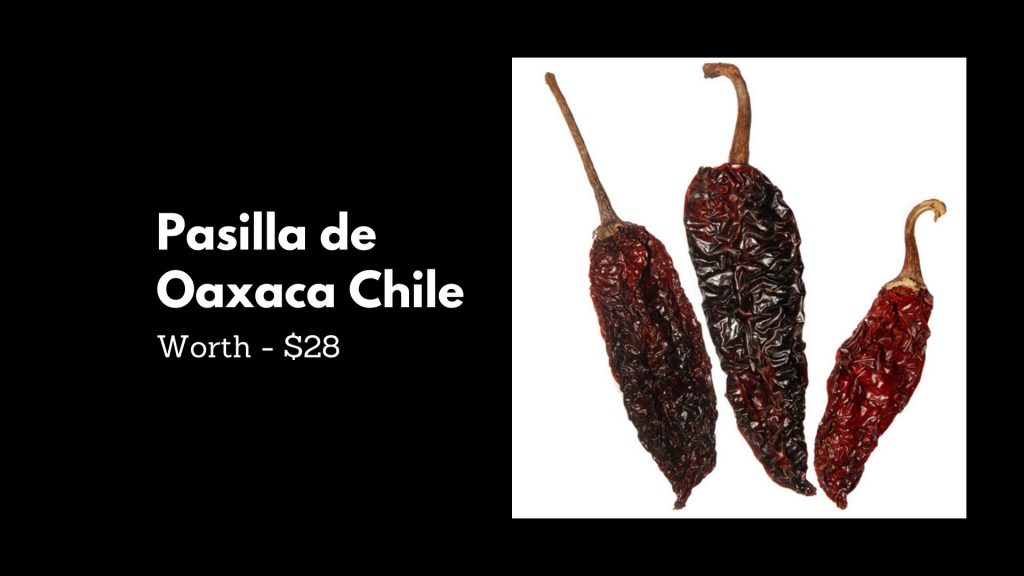
Pasilla de Oaxaca Chile is considered one of the Most Expensive Spices, famous for its smoky flavor. Pasilla de Oaxaca chile is a type of chili pepper from the Oaxaca area in Mexico. It's a smoked chili that's dried over a wood fire, giving it a unique smoky taste and smell. This chili is often used in traditional Oaxacan cooking to make dishes more interesting and flavorful.
The Pasilla de Oaxaca chile is not very hot, with a Scoville heat rating of about 1,500 to 2,500. They are dark brown and look wrinkled, with flesh that's not too thick. The smoky taste of the chili is mixed with a little bit of sweetness and a fruity hint.
In Oaxacan recipes, Pasilla de Oaxaca is used in many dishes like moles, salsas, stews, and soups. It's often mixed with other chili peppers to create layers of spice flavors. Outside of Mexico, this chili is becoming more popular with chefs and home cooks who like trying new and tasty ingredients.
You can find Pasilla de Oaxaca chile peppers in both dried and powdered forms. If you use the dried ones, you need to soak them in hot water before cooking. The powder can be used in rubs, sauces, and spice mixes.
Pasilla de Oaxaca chile is a tasty and flexible ingredient that brings a smoky, rich flavor to many different types of dishes.
Uses of Spices
Spices are a needed element of cookery across the world. They add flavour, aroma, and colour to dishes, making them more charming and mouthwatering. The use of spices can be outlined back to ageing moments when they were used for healing purposes as well as culinary.
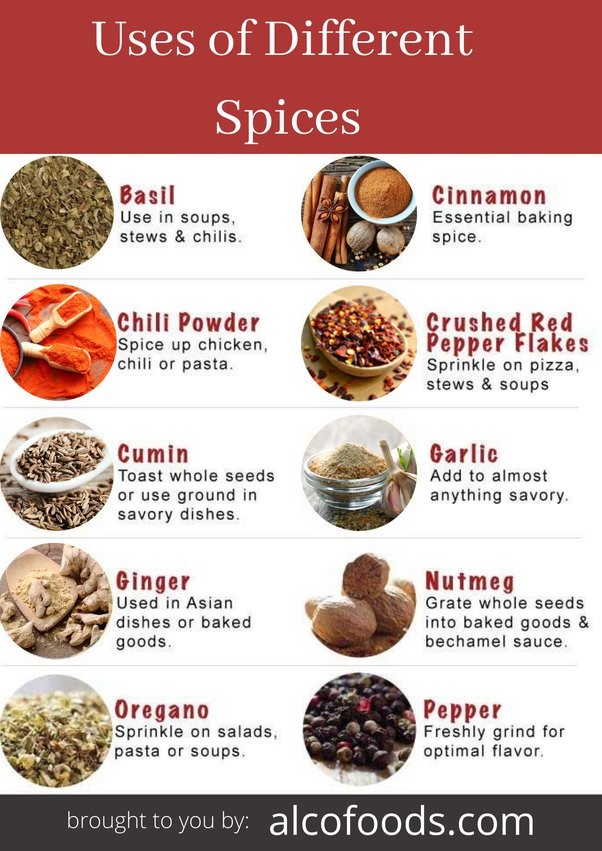
One of the immediate uses of spices is to enhance the flavour of food. Spices like cumin, cinnamon, turmeric, and gusto are generally used in numerous cookeries to add depth and complication to dishes. For illustration, cumin is used in Indian and Mexican cookery to add a nutty and warm flavour, while cinnamon is used in sweet and savoury dishes to add a sweet and slightly racy taste.
Fragrances are also used to add aroma to dishes. Spices like cardamom, cloves, and star anise are generally used in Indian, Middle Eastern, and Southeast Asian cookery to add a rich and ambrosial fragrance to dishes. They're also used in scents, detergents, and other perfumed products.
In addition to flavour and aroma, spices also have health benefits. numerous spices have anti-inflammatory, antioxidant, and antimicrobial parcels that can ameliorate digestion, boost impunity, and help certain conditions. For illustration, turmeric, which is generally used in Indian cookery, contains an emulsion called curcumin that has anti-inflammatory parcels and may help reduce the threat of habitual conditions similar to heart complaints, cancer, and Alzheimer's complaint.
Spices can alike be used for conservation. In ancient times, spices like cinnamon, cloves, and nutmeg were used to save meat and other perishable foods. They've antimicrobial parcels that can hamper the growth of bacteria and other microorganisms, thereby conserving the food for long ages.
Eventually, spices are also operated in potables. Spices like cinnamon, nutmeg, and gusto are generally used in hot potables like tea and coffee to add flavour and warmth. They're also used in alcoholic potables like milled wine and seasoned rum to add flavour and complexity.
Spices are an integral part of cookery and have a diversity of uses, including sweetening flavour, adding aroma, perfecting health, conserving food, and spicing potables.
Important Statistics To Be Noted
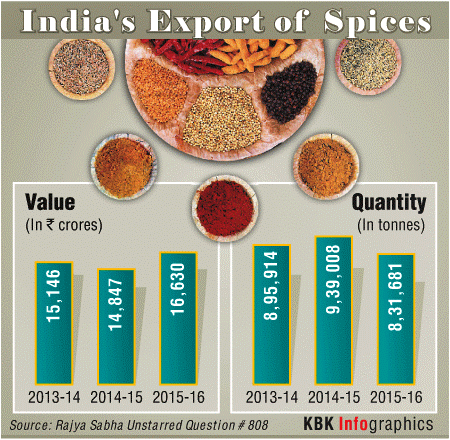
Spices are an imperative element of numerous cookeries worldwide, adding flavour, aroma, and colour to dishes. Some statistics that must be noted:
- Global Spice Request: The global spice request was evaluated at$12.7 billion in 2019 and is jutted to reach$17.3 billion by 2027, raising at a CAGR of 4.2 during the cast period.
- Utmost Delivered Spices: The most delivered spices in the world are pitch-black pepper, chilli pepper, cumin, and gusto. India is the largest patron of spices, followed by China and Indonesia.
- Uutmost Devoured Spices: The most consumed spices encyclopedically are pepper, cumin, cinnamon, and turmeric. In the United States, the most generally used spices are black pepper, garlic grease paint, onion grease paint, and chilli grease paint.
- Health Benefits: Numerous spices are known for their fitness benefits. For illustration, turmeric has anti-inflammatory parcels, while cinnamon can lower blood sugar situations. gusto is known to palliate nausea and vomiting, and garlic has vulnerable-boosting parcels.
- Organic Spices: The claim for organic spices is culturing due to adding mindfulness of health aids and environmental enterprises. The global organic spice request size is anticipated to reach$1.5 a billion by 2027.
- Spice Blends: Spice composites, similar to curry grease paint and garam masala, are getting decreasingly popular. These composites are an admixture of several spices, which are accounted for and mingled at specific rates to produce an alone flavour profile.
- Uses of Spices: Spices aren't only used in cuisine but also in drugs, cosmetics, and scents. For illustration, cloves are used in dental treatments, and saffron is used in scents and skincare products.
- The Global spice request is growing, with India being the largest patron of spices. Spices aren't only used in cuisine but also have health benefits and are used in colourful other diligence. The demand for organic spices and spice composites is also adding.
Conclusion
Spices have been an integral part of a mortal culture thousands of times. They're used in cuisine, drug, and religious observances, and have been valued for their unique flavours and wellness aids. Spices come in a variety of forms, comprehending whole, ground, and dried, and are deduced from the colourful corridors of shops, including seeds, roots, dinghies, and leaves.
Spices not only refine the taste of food, but they also have several health aids. For illustration, turmeric is comprehended for its anti-inflammatory parcels, while cinnamon is believed to help regulate blood sugar situations. Spices are also rich in antioxidants, which help cover the body from detriment caused by free revolutionaries.
The use of spices has developed over time, with new kinds and composites being acquainted with suit changing tastes and cookeries. moment, spices are extensively available and used around the world, with different societies having their unique spice blends and traditions.
Spices play a pivotal part in the culinary world and have multitudinous health benefits. They've been used by humans thousands of times and continue to be a historic part of our diurnal lives. As we continue to explore new flavours and cookeries, the use of spices will continue to evolve and expand.

Aditi is an Industry Analyst at Enterprise Apps Today and specializes in statistical analysis, survey research and content writing services. She currently writes articles related to the "most expensive" category.


